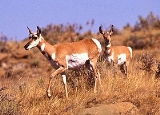
Pecora
Encyclopedia
The Pecora is a group of hoofed mammals that comprises most of the ruminant
s, including cattle, sheep, goats, antelopes,
deer, giraffes, and pronghorn. The only extant members of the Ruminantia
that are not pecorans are the chevrotain
s, which lack horns and whose four-chambered stomach is less developed than those of the pecorans. This gives rise to the pecorans sometimes being called "horned ruminants". Pecorans are also known as "higher ruminants", because they arose more recently than other ruminant groups. Although Pecora is a well-supported clade
, the exact relationships among families within it are in dispute.
Ruminant
A ruminant is a mammal of the order Artiodactyla that digests plant-based food by initially softening it within the animal's first compartment of the stomach, principally through bacterial actions, then regurgitating the semi-digested mass, now known as cud, and chewing it again...
s, including cattle, sheep, goats, antelopes,
deer, giraffes, and pronghorn. The only extant members of the Ruminantia
Ruminantia
Ruminantia includes many of the well-known large grazing or browsing mammals: among them cattle, goats, sheep, deer, and antelope. All members of the Ruminantia are ruminants: they digest food in two steps, chewing and swallowing in the normal way to begin with, and then regurgitating the...
that are not pecorans are the chevrotain
Chevrotain
Chevrotains, also known as mouse deer, are small ungulates that make up the family Tragulidae, the only members of the infraorder Tragulina. There are 10 living species in three genera, but there are also several species only known from fossils...
s, which lack horns and whose four-chambered stomach is less developed than those of the pecorans. This gives rise to the pecorans sometimes being called "horned ruminants". Pecorans are also known as "higher ruminants", because they arose more recently than other ruminant groups. Although Pecora is a well-supported clade
Clade
A clade is a group consisting of a species and all its descendants. In the terms of biological systematics, a clade is a single "branch" on the "tree of life". The idea that such a "natural group" of organisms should be grouped together and given a taxonomic name is central to biological...
, the exact relationships among families within it are in dispute.
Classification
- ORDER Artiodactyla
- Suborder SuinaSuinaThe suborder Suina are lineage of mammals that today includes the families Suidae and Tayassuidae and their fossil kin.- Classification :The suborder Suina includes Suidae and Tayassuidae...
- Suborder TylopodaTylopodaTylopoda is a suborder of terrestrial herbivorous even-toed ungulates belonging to Artiodactyla. They are extant in the wild in their native ranges of South America and Asia, while Australian feral camels are an introduced species. The group has a long fossil history in North America and Europe...
- Suborder CetruminantiaCetruminantiaCetruminantia is a clade made up of the Cetacodontamorpha and their closest living relatives, the ruminants....
- Infraorder Pecora
- Family Cervidae: deerDeerDeer are the ruminant mammals forming the family Cervidae. Species in the Cervidae family include white-tailed deer, elk, moose, red deer, reindeer, fallow deer, roe deer and chital. Male deer of all species and female reindeer grow and shed new antlers each year...
- Family †Gelocidae
- Family †PalaeomerycidaePalaeomerycidaePalaeomerycidae is an extinct family of ruminants , probably ancestral to deer and musk deer...
- Family †Hoplitomerycidae
- Family †ClimacoceratidaeClimacoceratidaeClimacoceratidae is a family of superficially deer-like artiodactyl ungulates that were restricted to the Miocene of Africa. They are close to the ancestry of giraffes, with some genera, such as Prolibytherium, having originally identified as being giraffes.The climacoceratids, namely, of what is...
- Family GiraffidaeGiraffidaeThe giraffids are ruminant artiodactyl mammals that share a common ancestor with deer and bovids. The biological family Giraffidae, once a diverse group spread throughout Eurasia and Africa, contains only two living members, the giraffe and the okapi. Both are confined to sub-saharan Africa: the...
: giraffeGiraffeThe giraffe is an African even-toed ungulate mammal, the tallest of all extant land-living animal species, and the largest ruminant...
and okapiOkapiThe okapi , Okapia johnstoni, is a giraffid artiodactyl mammal native to the Ituri Rainforest, located in the northeast of the Democratic Republic of the Congo, in Central Africa... - Family Antilocapridae: pronghornPronghornThe pronghorn is a species of artiodactyl mammal endemic to interior western and central North America. Though not an antelope, it is often known colloquially in North America as the prong buck, pronghorn antelope, or simply antelope, as it closely resembles the true antelopes of the Old World and...
- Family †Leptomerycidae
- Family Moschidae: musk deerMusk deerMusk deer are artiodactyls of the genus Moschus, the only genus of family Moschidae. They are more primitive than the cervids, or true deer, in not having antlers or facial glands, in having only a single pair of teats, and in possessing a gall bladder, a caudal gland, a pair of tusk-like teeth...
- Family Bovidae: cattleCattleCattle are the most common type of large domesticated ungulates. They are a prominent modern member of the subfamily Bovinae, are the most widespread species of the genus Bos, and are most commonly classified collectively as Bos primigenius...
, goatGoatThe domestic goat is a subspecies of goat domesticated from the wild goat of southwest Asia and Eastern Europe. The goat is a member of the Bovidae family and is closely related to the sheep as both are in the goat-antelope subfamily Caprinae. There are over three hundred distinct breeds of...
s, sheep, and antelopeAntelopeAntelope is a term referring to many even-toed ungulate species indigenous to various regions in Africa and Eurasia. Antelopes comprise a miscellaneous group within the family Bovidae, encompassing those old-world species that are neither cattle, sheep, buffalo, bison, nor goats...
- Family Cervidae: deer
- Infraorder Pecora
- Suborder Suina

